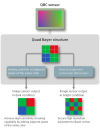Yes, Mavic pro uses full D-Log. Air and Mini series use D-Log-M, which is technically not a full logarithmic profile. It’s better than nothing but it is not full D-Log. That said, it is still pretty amazing.
However, it is not raw video. There is still a huge differentiation between recording in Log, which still gets compressed into an H.264/H.265 compression, and recording video in raw, where every frame is pretty much a raw photo. Full raw also comes with gigantic files; think about 1GB per second of video.
Although, the Mavic series is supposed to get Apple ProRes 4:2:2 video recording capabilities from what I have heard, if it isn’t already available (don’t know that much about Mavic series). Apple ProRes, however, is still not raw video, but it has much much less compression than something like H.265, giving you much much more latitude when editing your footage due to having only minor (sometimes lossless) compression.










